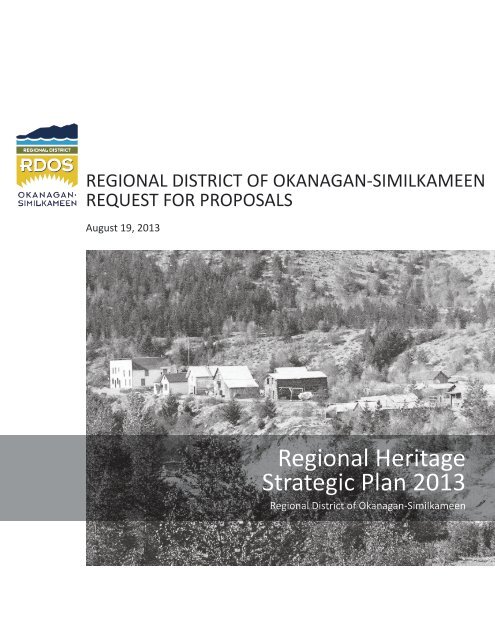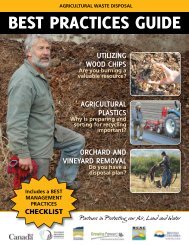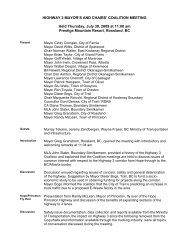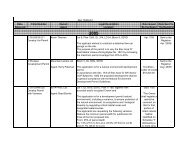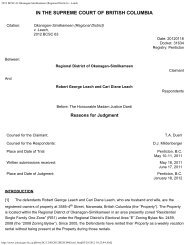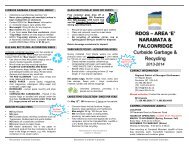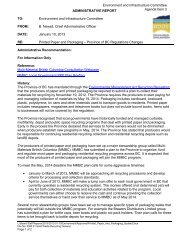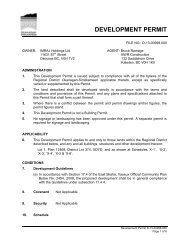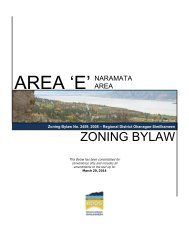Regional Heritage Strategic Plan 2013 - Rdosmaps.bc.ca
Regional Heritage Strategic Plan 2013 - Rdosmaps.bc.ca
Regional Heritage Strategic Plan 2013 - Rdosmaps.bc.ca
Create successful ePaper yourself
Turn your PDF publications into a flip-book with our unique Google optimized e-Paper software.
REGIONAL DISTRICT OF OKANAGAN-SIMILKAMEEN<br />
REQUEST FOR PROPOSALS<br />
August 19, <strong>2013</strong><br />
<strong>Regional</strong> <strong>Heritage</strong><br />
<strong>Strategic</strong> <strong>Plan</strong> <strong>2013</strong><br />
<strong>Regional</strong> District of Okanagan-Similkameen
This page is intentionally left blank.
REGIONAL DISTRICT<br />
OF OKANAGAN-SIMILKAMEEN<br />
REQUEST FOR PROPOSALS<br />
REGIONAL HERITAGE STRATEGIC PLAN<br />
DEFINITIONS.......................................................................... 2<br />
1. INTRODUCTION.............................................................. 2<br />
1.1. PURPOSE................................................................ 2<br />
1.2. BACKGROUND........................................................ 2<br />
2. INSTRUCTIONS TO PROPONENTS................................... 3<br />
2.1. SUBMISSION OF PROPOSALS.................................. 3<br />
2.2. INQUIRIES............................................................... 3<br />
3. GENERAL TERMS OF PROPOSAL PROCESS...................... 4<br />
3.1. PROPOSAL PREPARATION COSTS............................ 4<br />
3.2. INTENTION OF THE RDOS....................................... 4<br />
3.3. PROPOSAL PRESENTATION..................................... 5<br />
3.4. PROPOSAL CONFIDENTIALITY<br />
AND PROPRIETARY INFORMATION.......................... 5<br />
3.5. CONFLICT OF INTEREST.......................................... 5<br />
3.6. NO COLLUSION....................................................... 5<br />
3.7. LITIGATION............................................................. 6<br />
3.8. NO CONTRACT........................................................ 6<br />
3.9. ACCEPTANCE OF PROPOSAL................................... 6<br />
3.10. PROPOSAL CONTENT.............................................. 6<br />
3.11. SUBCONTRACTORS................................................. 7<br />
3.12. PROPOSAL CONTENT & INNOVATION..................... 7<br />
3.13. WORKERS COMPENSATION ACT ............................ 7<br />
4. SCOPE OF WORK AND SCHEDULE................................... 7<br />
4.1. STATEMENT OF UNDERSTANDING.......................... 7<br />
4.2. DRAFT SCHEDULING............................................... 8<br />
4.3. OBJECTIVES............................................................ 8<br />
4.4. SCOPE.................................................................... 8<br />
5. INFORMATION REVIEW................................................. 10<br />
6. SUMMARY OF DELIVERABLES....................................... 10<br />
7. REPORTING REQUIREMENTS........................................ 10<br />
8. COMMUNICATIONS...................................................... 11<br />
9. FEES AND DISBURSEMENTS.......................................... 11<br />
APPENDIX A – RFP EVALUATION FORMAT ……………............. 13<br />
APPENDIX B – CONSULTING SERVICES AGREEMENT..…....... 19<br />
APPENDIX C – RDOS HERITAGE INVENTORY......................... 29<br />
APPENDIX D – VALUES BASED MANAGEMENT.................... 33<br />
Front Cover: Granite City before the fire of 1912<br />
Opposite: Northbound KVR freight train passing Petley’s Point on Skaha Lake.<br />
[<strong>ca</strong> 1980]. Photo: Penticton Museum and Archives PMA9053<br />
<strong>Regional</strong> <strong>Heritage</strong> Strategy | Request for Proposals
REGIONAL DISTRICT OF<br />
OKANAGAN-SIMILKAMEEN<br />
REQUEST FOR PROPOSALS:<br />
REGIONAL HERITAGE STRATEGIC PLAN<br />
Keremeos Grist Mill and Gardens<br />
DEFINITIONS<br />
“CONTRACTOR or CONSULTANT” means the Proponent whose Proposal has been accepted by the <strong>Regional</strong><br />
District and is awarded a contract by the <strong>Regional</strong> District to <strong>ca</strong>rry out the Work<br />
“PROPONENT” means the responder to this RFP<br />
“PROPOSAL” means a proposal to <strong>ca</strong>rry out the Work submitted by a Proponent in response to this RFP.<br />
“REGIONAL DISTRICT” means the <strong>Regional</strong> District of Okanagan-Similkameen<br />
“RFP” means this Request for Proposals.<br />
“WORK” means and includes anything and everything required to be done for fulfillment and completion of the<br />
project in accordance with this RFP and Proposal.<br />
1. INTRODUCTION<br />
1.1. PURPOSE<br />
The <strong>Regional</strong> District of Okanagan Similkameen (RDOS) is requesting submission of proposals from qualified<br />
proponents for the development of a <strong>Regional</strong> <strong>Heritage</strong> <strong>Strategic</strong> <strong>Plan</strong> (RHSP). The purpose of the RHSP is<br />
to identify existing heritage sites and values throughout the region and ultimately define future direction,<br />
policies, priorities, standards and actions for the <strong>Regional</strong> District and its partners with respect to heritage<br />
planning in the region. The RHSP is a strategic plan that will provide the basic framework to define and guide<br />
a regional heritage implementation strategy over the next five years (2014-2019) as well as provide long term<br />
recommendations over the next ten years (2014-2024).<br />
1.2. BACKGROUND<br />
The RDOS Board has identified as a Corporate Objective in <strong>2013</strong> to undertake the development of a regional<br />
<strong>Heritage</strong> Strategy. The <strong>Regional</strong> District enabled Section 27 of the Lo<strong>ca</strong>l Government Act (<strong>Heritage</strong> Conservation)<br />
in December 2007 to allow the integration of heritage conservation into land use planning, procedures<br />
for developers and heritage property owners incentives to deter offences against heritage resources, the<br />
<strong>Regional</strong> <strong>Heritage</strong> Strategy | Request for Proposals August <strong>2013</strong> | 2
authority to work with lo<strong>ca</strong>l groups and<br />
organizations, including First Nations,<br />
and finally heritage stewardship<br />
activities in association with provincial<br />
agencies. A heritage bylaw currently<br />
exists in 5 out of 8 Electoral Areas<br />
within the <strong>Regional</strong> District (‘A’, ‘C’, ‘D’,<br />
‘G’ and ‘H’).<br />
2. INSTRUCTIONS TO PROPONENTS<br />
2.1. SUBMISSION OF PROPOSALS<br />
The Proposal submission should be<br />
clearly marked with the name and<br />
address of the Proponent and the RFP<br />
program title, and be addressed to the<br />
following:<br />
Lindsay Bourque<br />
Rural Projects Coordinator<br />
<strong>Regional</strong> District of<br />
Okanagan-Similkameen<br />
101 Martin Street<br />
Penticton, B.C. V2A 5J9<br />
Spotted Lake/ Khiluk - West of Osoyoos<br />
Proposals must be received on or before the Closing Time of:<br />
TIME: 2:00pm lo<strong>ca</strong>l time<br />
DATE: September 19, <strong>2013</strong><br />
Proposals received by email and/or hardcopy (enclose 3 copies) will be accepted until the Closing Time<br />
specified. It is the Proponent’s sole responsibility to ensure its Proposal is received at the address or email set<br />
out above by the Closing Time.<br />
Proposals received after the Closing Time will not be accepted or considered and hard copies will be returned<br />
to the Proponent at the Proponent’s expense.<br />
2.2. INQUIRIES<br />
All inquiries related to this RFP should be directed to the following project contact, preferably in writing.<br />
Lindsay Bourque<br />
(250) 490-4218<br />
lbourque@rdos.<strong>bc</strong>.<strong>ca</strong><br />
Proponents shall <strong>ca</strong>refully examine the RFP documents and shall fully inform themselves as to the intent,<br />
existing conditions and limitations which may affect their Proposal submission. No consideration will be given<br />
after submission of a Proposal to any claim that there was any misunderstanding with respect to the conditions<br />
imposed.<br />
Proponents finding discrepancies or omissions in the Contract or RFP, or having doubts as to the meaning or<br />
intent of any provision, should immediately notify the above listed project contact. If there are any changes,<br />
<strong>Regional</strong> <strong>Heritage</strong> Strategy | Request for Proposals August <strong>2013</strong> | 3
additions, or deletions to the Proposal scope, conditions, or closing date, Proponents will be advised by means<br />
of an Addendum issued by the <strong>Regional</strong> District. All Addenda is to become part of the Proposal Documents<br />
and receipt of Addenda should be acknowledged by the Proponent in the submission.<br />
Verbal discussion between the <strong>Regional</strong> District Directors, or staff and a Proponent shall not become a part of<br />
the RFP or modify the RFP unless confirmed by written Addendum.<br />
3. GENERAL TERMS OF PROPOSAL PROCESS<br />
3.1. PROPOSAL PREPARATION COSTS<br />
All expenses incurred by the Proponent in preparation and submission of this Proposal are to be borne by the<br />
Proponent, with the express understanding that no claims for reimbursements against the <strong>Regional</strong> District, or<br />
any of its member municipalities, will be accepted. The <strong>Regional</strong> District shall not be responsible for any costs<br />
involved in or associated with any meetings, discussion or negotiation following submission that could lead to<br />
acceptance of the Proposal and award of a contract.<br />
3.2. INTENTION OF THE RDOS<br />
The <strong>Regional</strong> District recognizes that “Best Value” is the essential part of purchasing a product and/ or service<br />
and therefore the <strong>Regional</strong> District may prefer a Proposal with a higher price, if it offers greater value and better<br />
serves the <strong>Regional</strong> District’s interests, as determined by the <strong>Regional</strong> District, over a Proposal with a lower<br />
price. Appendix A contains the information regarding how Proposals will be evaluated. The evaluation team<br />
will not be limited to the criteria listed in Appendix A, and the evaluation team may consider other criteria<br />
that the team identifies as relevant<br />
during the evaluation process.<br />
However, any criteria considered<br />
will be applied evenly and fairly to<br />
all Proposals.<br />
The <strong>Regional</strong> District, at its sole<br />
discretion, reserves the right to:<br />
• Reject any or all Proposals<br />
whether complete or not<br />
• Reject any Proposal it considers<br />
not in its best interests<br />
• Waive any minor irregularity<br />
or insufficiency in the Proposal<br />
submitted<br />
• Not be liable for misunderstandings<br />
or errors in the Request<br />
for Proposals<br />
• Issue addenda to the Request<br />
for Proposals<br />
• Contact references provided<br />
Vaseux Lake Pictographs<br />
by<br />
the Proponents<br />
• Retain independent persons or contractors for assistance in evaluating Proposals<br />
• Request points of clarifi<strong>ca</strong>tion to assist the <strong>Regional</strong> District in evaluating Proposals<br />
• Negotiate changes with the successful Proponent<br />
• Award separate contracts for separate work components, and<br />
<strong>Regional</strong> <strong>Heritage</strong> Strategy | Request for Proposals August <strong>2013</strong> | 4
• Withdraw the Request for Proposals<br />
3.3. PROPOSAL PRESENTATION<br />
The <strong>Regional</strong> District reserves the right to request one or more of the Proponents whose submissions are of<br />
particular interest to the <strong>Regional</strong> District, to make an oral presentation to the <strong>Regional</strong> District.<br />
3.4. PROPOSAL CONFIDENTIALITY AND PROPRIETARY INFORMATION<br />
All submissions become the property of the <strong>Regional</strong> District and will not be returned to the Proponent. The<br />
<strong>Regional</strong> District will consider all Proposals submitted as confidential but reserves the right to make copies<br />
of all Proposals received for its internal review and for review by its financial, accounting, legal, and techni<strong>ca</strong>l<br />
consultants.<br />
Proponents should be aware that the<br />
<strong>Regional</strong> District is a “public body” as<br />
defined in and subject to the provisions<br />
of the Freedom of Information and Protection<br />
of Privacy Act.<br />
If the Proponent believes any of the<br />
information requested in this RFP and<br />
provided by them is confidential, then<br />
they should identify it as such and provide<br />
a rationale as to why it should not<br />
be released under “Freedom of Information”<br />
legislation.<br />
The rationale for keeping information<br />
confidential under this legislation includes:<br />
a) Trade secrets of the Proponent;<br />
b) Financial, commercial, scientific<br />
or techni<strong>ca</strong>l information, the disclosure<br />
of which could reasonably<br />
Kaleden Co-operative Growers Packing House and Cold Storage building.<br />
cir<strong>ca</strong>: 1932. Photo: Penticton Museum and Archives PMA 1594<br />
be expected to result in material financial loss or gain or could reasonably<br />
be expected to prejudice the competitive position of the Proponent; or<br />
c) Information the disclosure of which could be reasonably expected to interfere with contractual or other<br />
negotiations of the Proponent.<br />
3.5. CONFLICT OF INTEREST<br />
A Proponent shall disclose in its Proposal any actual or potential conflicts of interest and existing business<br />
relationships it may have with the <strong>Regional</strong> District, its elected or appointed officials or employees. The <strong>Regional</strong><br />
District may rely on such disclosure.<br />
3.6. NO COLLUSION<br />
Except as otherwise specified or as arising by reason of the provision of the contract documents, no person<br />
whether natural, or body corporate, other than the Proponent has or will have any interest or share in this<br />
Proposal or in the proposed contract which may be completed in respect thereof. There is no collusion or<br />
arrangement between the Proponent and any other actual or prospective Proponents in connection with<br />
Proposals submitted for this project and the Proponent has no knowledge of the contents of other Proposals<br />
<strong>Regional</strong> <strong>Heritage</strong> Strategy | Request for Proposals August <strong>2013</strong> | 5
and has made no comparison of figures or agreement or arrangement, express or implied, with any other party<br />
in connection with the making of the Proposal.<br />
3.7. LITIGATION<br />
Proponents who, either directly or indirectly through another corporation or entity, have been or are in<br />
litigation, or who have served notice with intent to proceed with court action against the <strong>Regional</strong> District<br />
in connection with any contract for works or services, may be considered ineligible Proponents. Receipt of<br />
Proposals from such Proponents may be disqualified from the evaluation process.<br />
3.8. NO CONTRACT<br />
This RFP is not a tender and does not commit the <strong>Regional</strong> District in any way to select a preferred Proponent.<br />
By submitting a Proposal and participating in the process as outlined in this RFP, Proponents expressly agree<br />
that no contract of any kind is formed under, or arises from, this RFP, prior to the signing of a formal written<br />
Contract.<br />
3.9. ACCEPTANCE OF PROPOSAL<br />
The acceptance of a Proposal will be made in writing from the <strong>Regional</strong> District, and will be addressed to the<br />
successful Proponent at the address given in the submitted Proposal. Following acceptance and approval to<br />
proceed with the Proposal, the Proponent is expected to enter into a contract with the <strong>Regional</strong> District to<br />
perform the works or services set out and agreed upon in the Proposal.<br />
The agreement that the successful Proponent will be expected to execute with the <strong>Regional</strong> District will<br />
contain terms similar to those contained in the draft Contracting Services Agreement provided in Appendix<br />
B. The agreement attachments will include the entire Request for Proposal, the Proponent’s total Proposal<br />
submission and any mutually agreed upon modifi<strong>ca</strong>tions, changes or negotiated adjustments.<br />
3.10. PROPOSAL CONTENT<br />
Content to be included in the Proposal:<br />
• Full name, address and telephone number of the submitting office of the Proponent and where appli<strong>ca</strong>ble,<br />
the name, address and telephone number of any branch office, affiliate or su<strong>bc</strong>onsultant(s) that will be<br />
involved in the project.<br />
• Project Manager: The Proposal shall identify the proposed project manager who will be the single<br />
point of contact, responsible for direct interaction with the <strong>Regional</strong> District. State his/ her position and<br />
professional discipline. Describe the work to be performed by the project manager, his/ her qualifi<strong>ca</strong>tions<br />
and substantive experience directly related to the proposed Work.<br />
• Proposed Project Team: The Proposal shall list key individuals including the project manager who will have<br />
major responsibilities for the performance of the Work. Describe the work to be performed by each listed<br />
individual and their qualifi<strong>ca</strong>tions in terms of edu<strong>ca</strong>tion and substantive experience directly related to the<br />
proposed project.<br />
The Proposal should include the following endorsement: “Identified Key Project Team members<br />
shall only be replaced with written approval of the <strong>Regional</strong> District.”<br />
• Methodology: Describe briefly the methodology as to how the Work will be <strong>ca</strong>rried out. Discuss how<br />
each task will be <strong>ca</strong>rried out and what services or interaction is required from/with the <strong>Regional</strong> District.<br />
Suggest alternative, if appropriate. Identify any specialized equipment, unique approaches, or concepts or<br />
cost saving measures which your company may use relevant to the required services. Indi<strong>ca</strong>te what kind<br />
<strong>Regional</strong> <strong>Heritage</strong> Strategy | Request for Proposals August <strong>2013</strong> | 6
of software and tools you will be using to record, analyze and illustrate the information collected.<br />
• The Proposal shall contain an outline of strategies and skills that will be used to manage the project’s<br />
expectations, resources, budget and to ensure quality control.<br />
• References: The Proposal shall provide no less than two (2) references that are relevant to the proposed<br />
Work. The references should be from a third party who <strong>ca</strong>n provide information about the performance of<br />
the Proponent in delivering services for the experience cited.<br />
3.11. SUBCONTRACTORS<br />
The Proposal shall include the company name of all su<strong>bc</strong>ontractors and su<strong>bc</strong>onsultants proposed to be used in<br />
the performance of the Work with a description of the work they would be performing.<br />
The su<strong>bc</strong>ontractors and su<strong>bc</strong>onsultants listed in the Proposal may not be changed without the written consent<br />
of the <strong>Regional</strong> District. If the <strong>Regional</strong> District so requires, the Proponent shall be prepared to confirm to the<br />
<strong>Regional</strong> District the competence of su<strong>bc</strong>ontractors and su<strong>bc</strong>onsultants prior to acceptance of the Proposal.<br />
3.12. PROPOSAL CONTENT & INNOVATION<br />
The Proponent shall address in the Proposal submission, all the information as requested in the RFP<br />
documentation. The Proponent is also encouraged to include innovative, alternative or unique solutions to the<br />
Proposal subject that may, along with other things, indi<strong>ca</strong>te cost initiatives, improved environmental impacts,<br />
better public relations and/ or project acceptance, reduced risk, improved management or administrative<br />
efficiencies, etc. Any alternative Proposals submitted should include all the requirements of the original RFP<br />
with costs identified for comparative purposes.<br />
3.13. WORKERS COMPENSATION ACT<br />
The Proponent, and any proposed su<strong>bc</strong>ontractors and su<strong>bc</strong>onsultants, should provide a Work Safe BC (Workers<br />
Compensation Board) Registration Number in the Proposal and shall at the time of signing a contract agreement,<br />
provide proof of payment of claims in good standing with Work Safe BC.<br />
4. SCOPE OF WORK<br />
AND SCHEDULE<br />
The Proponent’s proposal shall<br />
address and include the following<br />
sections as specified:<br />
4.1. STATEMENT OF<br />
UNDERSTANDING<br />
Proponents shall provide a<br />
brief statement of introduction<br />
and overview of the scope and<br />
understanding of the region’s<br />
history and development in<br />
addition to existing heritage<br />
sites and groups. It is the<br />
Proponent’s responsibility to<br />
demonstrate that they possess<br />
the required knowledge, McGibbon Residence. Photo: Lynn Alaric.<br />
<strong>Regional</strong> <strong>Heritage</strong> Strategy | Request for Proposals August <strong>2013</strong> | 7
understanding and <strong>ca</strong>pacity to <strong>ca</strong>rry out the work as outlined in this RFP.<br />
4.2. DRAFT SCHEDULING<br />
Task<br />
Completion Date<br />
Phase 1 – Issue RFP August 19, <strong>2013</strong><br />
Phase 2 – RFP Closing Date September 19, <strong>2013</strong><br />
Phase 3 – RFP Evaluation, Stakeholder Meetings, Recommendations September 1 - 24, <strong>2013</strong><br />
Phase 4 – RFP Award, Stakeholder Meetings September 25, <strong>2013</strong><br />
Phase 5 – Context Study and Community Engagement October - November <strong>2013</strong><br />
Phase 6 – Analysis + Synthesis of Feedback December <strong>2013</strong><br />
Phase 7 – Interim report to RDOS Board January <strong>2013</strong><br />
Phase 8 – Economic Development Strategy February <strong>2013</strong><br />
Phase 9 – Regulatory Impact Assessment March <strong>2013</strong><br />
Phase 10 – Final Deliverables, RDOS Board Presentation April <strong>2013</strong><br />
4.3. OBJECTIVES<br />
Provide a clearly articulated vision that conveys where the strategic plan will take the region in five to ten years.<br />
To provide input into corporate work plans and budgets through performance measures on the following:<br />
• <strong>Plan</strong>ning Framework<br />
• Vision and Philosophy<br />
• <strong>Regional</strong> Interest and <strong>Heritage</strong> Register<br />
• Analysis, Recommendation, Implementation<br />
• <strong>Heritage</strong> Partnerships<br />
• Marketing and Promotion<br />
4.4. SCOPE<br />
Key areas to be addressed, but are not limited to, are:<br />
<strong>Plan</strong>ning Framework<br />
4.4.1. Conduct a review of RDOS Official Community <strong>Plan</strong>s, Zoning Bylaws and other planning document<br />
such as historic heritage plans and the <strong>Regional</strong> Trails Master <strong>Plan</strong> (2011) for integration<br />
opportunities.<br />
4.4.2. Conduct a Context Study using a Values-Based Management approach. The context study is a<br />
comprehensive but not an exhaustive examination of heritage in the Okanagan and Similkameen<br />
Valleys. The objective is to integrate the natural, First Nation and non-aboriginal heritage features<br />
and stories. In order to better comprehend heritage in the Okanagan Similkameen, the context study<br />
will create a thematic framework to <strong>ca</strong>pture and organize the information gathered.<br />
4.4.3. Identify and evaluate emerging trends in heritage planning, including new models for economic<br />
growth and development that <strong>ca</strong>n be applied to key heritage sites in the region.<br />
4.4.4. Provide recommendations to the RDOS Board regarding the establishment of a <strong>Regional</strong> District<br />
<strong>Heritage</strong> Advisory Commission and create a Terms of Reference for the Advisory group.<br />
<strong>Regional</strong> <strong>Heritage</strong> Strategy | Request for Proposals August <strong>2013</strong> | 8
Vision & Philosophy<br />
4.4.5. Design and implement a public consultation process to solicit community input using the Values-<br />
Based Management approach regarding heritage values in the area to determine community<br />
themes. This information will be synthesized to generate <strong>Regional</strong> themes.<br />
4.4.6. Develop a regional heritage policy for the RDOS through a public consultative process with<br />
residents, community groups and stakeholders. Consideration will need to be given to<br />
land and business owners, public access, heritage societies + advo<strong>ca</strong>cy groups, historians,<br />
archivists and cultural organizations.<br />
4.4.7. Assist in the development of a clear and concise vision and mission statements for <strong>Regional</strong> <strong>Heritage</strong><br />
within the RDOS.<br />
4.4.8. Based on the vision, mission and emerging trends, develop a <strong>Regional</strong> <strong>Heritage</strong> Strategy that meets<br />
existing and future needs of the RDOS and its Municipal partners, and includes setting out<br />
recommendations for future service levels.<br />
Sites of <strong>Regional</strong> Interest and <strong>Heritage</strong> Register<br />
4.4.9. Identify and prioritize potential heritage sites based on expressed values of communities throughout<br />
the region.<br />
4.4.10. Identify criteria for adding a potential heritage site to the <strong>Regional</strong> <strong>Heritage</strong> Registry.<br />
Analysis, Recommendation, and Implementation<br />
4.4.11. Create an Analysis of Key Findings respecting the RDOS <strong>Heritage</strong> Values.<br />
4.4.12. Create recommendations that are fundamental to meeting the Goals of the <strong>Regional</strong> <strong>Heritage</strong><br />
<strong>Strategic</strong> <strong>Plan</strong>. The recommendations are intended to be implemented over a short-to-long term<br />
time frame, as funding and resources allow.<br />
4.4.13. Create an Implementation <strong>Plan</strong> of the recommendations in the <strong>Regional</strong> <strong>Heritage</strong> <strong>Strategic</strong> <strong>Plan</strong><br />
over 5 years that includes a financial estimate for operations, programs and edu<strong>ca</strong>tional outreach for<br />
annual budgeting purposes.<br />
4.4.14. Provide RDOS with an impact assessment on integrating heritage into internal operations and<br />
provide recommendations regarding incorporating heritage planning policy into existing planning<br />
documents.<br />
<strong>Heritage</strong> Partnerships<br />
4.4.15. Outline the role of lo<strong>ca</strong>l and provincial partners including the Province of British Columbia, First<br />
Nations and lo<strong>ca</strong>l heritage groups for heritage designation and management over both the short and<br />
long term.<br />
4.4.16. Identify opportunities, benefits and costs of supporting heritage assets and management by<br />
non-profit organizations (heritage groups) providing guidelines for effective volunteer management<br />
practices.<br />
Marketing and Promotion<br />
4.4.17. Develop a heritage marketing and promotion plan as part of the economic development component<br />
of the RFP.<br />
<strong>Regional</strong> <strong>Heritage</strong> Strategy | Request for Proposals August <strong>2013</strong> | 9
5. INFORMATION REVIEW<br />
In addition to the resources listed in section 4.4.1, several communities throughout the RDOS have developed<br />
inventories of heritage resources which <strong>ca</strong>n inform the <strong>Regional</strong> <strong>Heritage</strong> Strategy. An Okanagan Similkameen<br />
<strong>Heritage</strong> Resource Inventory was prepared in March, 1988 (available for down load on our website) based on<br />
existing community inventories at that time. These inventories are generally maintained by heritage organizations.<br />
Existing heritage organizations operating within the RDOS are:<br />
1. Princeton Museum and Archives<br />
2. Hedley Museum<br />
3. Upper Similkameen Indian Band<br />
4. Keremeos Museum Society<br />
5. Lower Similkameen Indian Band<br />
6. Osoyoos Museum Society<br />
7. Oliver and District <strong>Heritage</strong> Society<br />
8. Osoyoos Indian Band [Nk’mip Desert Cultural Centre]<br />
9. Kaleden Museum Society<br />
10. Okanagan Falls Museum Society<br />
11. Penticton Museum and archives<br />
12. Penticton Indian Band [Enow’kin Centre]<br />
13. Summerland Museum and Archives<br />
14. Naramata <strong>Heritage</strong> Museum<br />
15. Okanagan Histori<strong>ca</strong>l Society [Penticton, South Okanagan, Similkameen and Summerland Branches]<br />
Other existing heritage tools include:<br />
1. <strong>Regional</strong> District of Okanagan-Similkameen Electoral Areas A, C, D, G and H <strong>Heritage</strong><br />
Conservation Service Bylaw No. 2367, 2007<br />
2. <strong>Heritage</strong> Advisory Committee, Bylaw No. 250<br />
3. Naramata <strong>Heritage</strong> Museum and Histori<strong>ca</strong>l Sites Contribution Lo<strong>ca</strong>l Service Establishment Bylaw<br />
No. 1946<br />
4. Oliver and District Community <strong>Heritage</strong> <strong>Strategic</strong> <strong>Plan</strong><br />
General Reference:<br />
Dynamic Downtowns Workbook: Using <strong>Heritage</strong> to Build Strong, Vibrant Downtowns 1<br />
6. SUMMARY OF DELIVERABLES:<br />
The successful proponent will be required to provide an integrated plan that accurately illustrates the current state<br />
of heritage in the region and outlines the future direction, policies, priorities, and actions to be taken by the RDOS<br />
with respect to achieving our goals for existing and future heritage sites. The proponent will also be required to<br />
make a presentation to the Board of Directors upon completion of the plan. The <strong>Regional</strong> <strong>Heritage</strong> <strong>Strategic</strong> <strong>Plan</strong><br />
should at minimum address those items listed in the “Objectives” and “Scope” of the RFP document.<br />
7. REPORTING REQUIREMENTS<br />
Submit three (3) hard copies and one (1) electronic copy of all final reports, spreadsheets and associated documents<br />
to the <strong>Regional</strong> District. Electronic copies shall be provided in PDF format and/or MS Word, Excel or design file as<br />
requested by the RDOS for review and markup.<br />
1 http://www.for.gov.<strong>bc</strong>.<strong>ca</strong>/ftp/heritage/external/!publish/web/DynamicDowntownsWorkbook_Final.pdf<br />
<strong>Regional</strong> <strong>Heritage</strong> Strategy | Request for Proposals August <strong>2013</strong> | 10
Drawings shall meet standards acceptable to the <strong>Regional</strong> District’s Geographi<strong>ca</strong>l Information Systems (GIS)<br />
department and be prepared and presented in SI units and use Geodetic datum and UTM Nad 83 coordinates.<br />
For all record drawings or asbuilts, three (3) hard copies and one electronic DWG and PDF copy shall be submitted<br />
to the <strong>Regional</strong> District.<br />
8. COMMUNICATIONS<br />
The consultant will provide a minimum of one interim report outlining the status of the project.<br />
The public consultation process must include but not limited to:<br />
• Consultation with the <strong>Regional</strong> District Community Services Department<br />
• Interviews with community organizations (heritage societies and advo<strong>ca</strong>cy groups, historians, archivists,<br />
cultural organizations, First Nations and business associations), member municipalities, and other<br />
government organizations<br />
• A public survey or poll conducted through a random sample of RDOS residents<br />
• Use of social media tools, RDOS website to provide opportunities for public comments<br />
A minimum of two series of region wide open houses in the lo<strong>ca</strong>tions below to solicit views, comments and<br />
opinions on:<br />
• The lo<strong>ca</strong>l heritage values within the RDOS<br />
• To present the draft <strong>Regional</strong> <strong>Heritage</strong> Strategy and receive comments prior to the preparation of the final<br />
document.<br />
The <strong>Regional</strong> District comprises 8 electoral areas, five member municipalities and 3 Indian Bands; to ensure a<br />
broad public participation and involvement, it is expected that each series of open houses will be conducted to<br />
accommodate the electoral areas and municipality lo<strong>ca</strong>tions.<br />
The consultant will be required to present the draft report to the Board prior to final version.<br />
9. FEES AND DISBURSEMENTS<br />
The total cost of the project shall include:<br />
• A maximum fee up to and including completion of the <strong>Regional</strong> <strong>Heritage</strong> Strateg. The maximum costs<br />
will include all taxes, labour, equipment, and sub-consultant fees. Any costs incurred by the Consultant<br />
above the submitted maximum cost will be the sole responsibility of the Consultant unless approved by<br />
the <strong>Regional</strong> District.<br />
• Work schedule to show a cost of each major component and identify key tasks to complete the project<br />
including overall timeline required.<br />
• The Consultant will include details in their proposal on what services the <strong>Regional</strong> District will need to<br />
<strong>ca</strong>rry out over the course of the work<br />
<strong>Regional</strong> <strong>Heritage</strong> Strategy | Request for Proposals August <strong>2013</strong> | 11
This page is intentionally left blank.
REGIONAL DISTRICT<br />
OF OKANAGAN-SIMILKAMEEN<br />
REQUEST FOR PROPOSALS<br />
REGIONAL HERITAGE STRATEGIC PLAN<br />
APPENDIX “A”<br />
REQUEST FOR PROPOSALS<br />
EVALUATION FORMAT<br />
<strong>Regional</strong> <strong>Heritage</strong> Strategy | Request for Proposals<br />
August <strong>2013</strong> | 13 A
This page is intentionally left blank.
APPENDIX “A”<br />
REQUEST FOR PROPOSALS EVALUATION FORM<br />
Proponent’s Name: _________________________________________________<br />
Project Title: REGIONAL HERITAGE STRATEGIC PLAN – <strong>2013</strong><br />
Evaluation Date: ___________________________________________________<br />
Evaluator: ________________________________________________________<br />
Step 1: YES NO<br />
Proposal received prior to closing<br />
Mandatories<br />
Su<strong>bc</strong>onsultants list submitted<br />
Project Manager identified<br />
Proposed schedule included<br />
Reference List<br />
Hourly rates provided<br />
Maximum or upset fee included<br />
Complete proposal as requested<br />
Step 2:<br />
Proponent (15-30<br />
points)<br />
Proposal (30-50<br />
points)<br />
Price (20-50 points)<br />
Assigned<br />
Points<br />
Qualifi<strong>ca</strong>tions of firm and project team members 10<br />
Experience of firm and project team members 10<br />
Past Performance / References 5<br />
Resources 5<br />
Scope 10<br />
Methodology 15<br />
Scheduling 5<br />
Project Team - Level of Effort 5<br />
Clarity of Proposal 15<br />
Points for Price = (lowest cost Proposal divided by<br />
Proposal being evaluated) x (20% weight)<br />
20<br />
Points<br />
Total Score Proponent + Proposal + Price Scores 100<br />
1. Requests for Proposals (RFP’s) shall be reviewed by an Evaluation Team, which shall<br />
consist of at least two staff members.<br />
2. Each Evaluation Team member shall complete the RFP Evaluation Form for each Proposal.<br />
3. Evaluation Team Members will use the following list of questions to complete the RFP<br />
Evaluation Form:<br />
<strong>Regional</strong> <strong>Heritage</strong> Strategy | Request for Proposals August <strong>2013</strong> | 15
Proponent Evaluation<br />
(i) Qualifi<strong>ca</strong>tions of Firm and Project Team Members<br />
Are the firm and project team members specialized and qualified in the nature of the<br />
project work<br />
(ii) Experience of Firm and Project Team Members<br />
Has the firm completed similar projects during the last three years Do the assigned<br />
project team members have experience with similar projects<br />
(iii) Past Performance<br />
Is the firm’s record of past performance sound Do reference checks reveal<br />
weaknesses Was abnormal level of monitoring required Does the firm consistently<br />
complete assignments on time and within budget<br />
(iv) Resources<br />
Does the firm have ample resources (e.g. staff, equipment, etc.) to apply to this project<br />
Proposal Evaluation<br />
(i) Scope<br />
Do the objectives, scope, work plan, and prediction of results comply with the terms of<br />
reference and project objectives<br />
(ii) Methodology<br />
Is the methodology clear and in sufficient detail to cover all necessary aspects Does<br />
the Proposal reflect the required understanding of the project Is each task clearly<br />
outlined and in logi<strong>ca</strong>l sequence<br />
(iii) Scheduling<br />
Does the Proposal indi<strong>ca</strong>te that the achievement of objectives will be met according to<br />
an acceptable schedule Are they within the timelines set by the terms of reference (if<br />
outlined in the terms of reference) Are problems or delays accounted for Is timing<br />
realistic for the project<br />
(iv) Project Team<br />
Is the level of effort (total hours) adequate, low or high Are the hours of professionals<br />
involved adequate, low or high Is the proportion of professional vs. techni<strong>ca</strong>l hours<br />
adequate or appropriate<br />
(v) Clarity of Proposal<br />
Is the Proposal clear, concise, and logi<strong>ca</strong>l<br />
Price Evaluation<br />
(i) Total Price<br />
4. Upon completion of Step 2, the Evaluation Team shall determine, by consensus, the score<br />
for each Proposal and will forward these scores to the Board for its consideration to select<br />
the successful Proponent.<br />
Environmental Performance Decision Criteria<br />
Basic evaluation criteria for rationalizing the purchase of environmentally sound alternatives:<br />
<strong>Regional</strong> <strong>Heritage</strong> Strategy | Request for Proposals August <strong>2013</strong> | 16
(i)<br />
Does the alternative product meet or exceed the minimum required performance<br />
specifi<strong>ca</strong>tions (e.g.) durability, safety, structural integrity. (If no, use the conventional<br />
product; if yes move to (ii)).<br />
(ii) Is the unit pricing of the alternative product equal, or less than, the conventional<br />
product (If yes purchase the alternate product; if no move to (iii)).<br />
(iii) What is the total annual cost differential of using the alternate product instead of the<br />
conventional (If the effect on budget is nominal use the alternate product; if the effect<br />
on budget is more than nominal go to (iv)).<br />
(iv) By using the alternate product are there any offsetting benefits that <strong>ca</strong>n be clearly<br />
measured and recorded in cost avoidance accruing to the same Business Unit, or to<br />
other business Units and, if so, do those benefits equal or exceed the extra acquisition<br />
costs (If yes purchase the alternate product; if no go to (v)).<br />
(v) Are there any other benefits that are not measurable in any direct monetary sense but<br />
are benefits that we ought to realize for other on-pecuniary reasons, e.g. “green<br />
benefits” such as reduced pollution, air emissions, effluent release, recyclable &<br />
disposal issues etc. (If no, purchase the conventional product; if yes define those<br />
reasons and report them through established reporting channels to get the increased<br />
budget commitment approved. In either <strong>ca</strong>se go to (vi).<br />
(vi) If acquisition of the alternative product at the higher cost is approved purchase the<br />
alternate product; if not purchase the conventional product.<br />
<strong>Regional</strong> <strong>Heritage</strong> Strategy | Request for Proposals August <strong>2013</strong> | 17
This page is intentionally left blank.
REGIONAL DISTRICT<br />
OF OKANAGAN-SIMILKAMEEN<br />
REQUEST FOR PROPOSALS<br />
REGIONAL HERITAGE STRATEGIC PLAN<br />
APPENDIX “B”<br />
CONSULTING SERVICES AGREEMENT<br />
<strong>Regional</strong> <strong>Heritage</strong> Strategy | Request for Proposals<br />
August <strong>2013</strong> | 19 B
This page is intentionally left blank.
APPENDIX “B”<br />
DRAFT CONSULTING SERVICES AGREEMENT<br />
THIS AGREEMENT made the ___________ day of __________________________ , 2011.<br />
BETWEEN :<br />
REGIONAL DISTRICT OF OKANAGAN-SIMILKAMEEN<br />
101 Martin Street<br />
Penticton, British Columbia, V2A 5J9<br />
(hereinafter <strong>ca</strong>lled the “<strong>Regional</strong> District”)<br />
OF THE FIRST PART<br />
AND :<br />
___________________________________________________________________<br />
___________________________________________________________________<br />
___________________________________________________________________<br />
(hereinafter <strong>ca</strong>lled the “Consultant”)<br />
OF THE SECOND PART<br />
WHEREAS the Consultant has agreed to provide certain professional services to the <strong>Regional</strong><br />
District in connection with a certain project described as follows:<br />
___________________________________________________________________<br />
___________________________________________________________________<br />
___________________________________________________________________<br />
___________________________________________________________________<br />
AND WHEREAS the parties hereto wish to set out herein their respective rights and<br />
obligations.<br />
NOW THEREFORE, the <strong>Regional</strong> District and the Consultant in consideration of their mutual<br />
rights and obligations as hereinafter set forth do hereby agree as follows:<br />
Article 1<br />
Consultant’s Duties<br />
1.1 The Consultant shall provide to the <strong>Regional</strong> District all services set out in the Request<br />
for Proposal (attached hereto as Schedule “A”) and the Consultant’s Proposal (attached<br />
hereto as Schedule “B”), both of which form part of this agreement.<br />
1.2 In performing the Services under this Agreement, the Consultant shall, at all times, act in<br />
the best interests of the <strong>Regional</strong> District and exercise that degree of professional skill,<br />
<strong>ca</strong>re and diligence required according to generally accepted professional science and<br />
engineering standards appli<strong>ca</strong>ble to the performance of such Services at the time and<br />
<strong>Regional</strong> <strong>Heritage</strong> Strategy | Request for Proposals August <strong>2013</strong> | 21
place the Services are performed.<br />
1.3 It is agreed that in awarding the professional services encompassed within this<br />
agreement to the Consultant, the <strong>Regional</strong> District has relied upon the Consultant’s<br />
representations concerning the experience of certain identified personnel in the employ<br />
of the Consultant. It is agreed that, in performing the services under this agreement, the<br />
Consultant shall assign such identified personnel to the project.<br />
1.4 The Consultant shall request of the <strong>Regional</strong> District any information or data contained in<br />
<strong>Regional</strong> District files which the Consultant requires in order to perform the services.<br />
The <strong>Regional</strong> District is only obligated to provide to the Consultant information and data<br />
that is pertinent to the terms of reference and work program set out in Schedules “A” and<br />
“B”. The Consultant may rely on such information or data as may be provided by the<br />
<strong>Regional</strong> District without independent verifi<strong>ca</strong>tion.<br />
1.5 To ensure that the Project is processed in a timely manner, the Consultant and the<br />
<strong>Regional</strong> District will apply their best efforts to meeting the following deadlines:<br />
a) Phone <strong>ca</strong>ll inquiries from the <strong>Regional</strong> District will be returned within 24 hours;<br />
b) Public inquiries to the Consultant on techni<strong>ca</strong>l issues will be returned within 48 hours;<br />
c) Meetings will be scheduled within 5 working days from date of request;<br />
d) Review comments for material submitted by the Consultant will be processed by the<br />
<strong>Regional</strong> District within 14 days of receipt.<br />
1.6 At the commencement of the Project, the Consultant shall, at the <strong>Regional</strong> District’s<br />
request, provide the <strong>Regional</strong> District with a detailed analysis of the cost estimate for<br />
each component of the project including a monthly and cumulative <strong>ca</strong>sh flow relative to<br />
the approved schedule of work. The cost estimates for fees and disbursements shall be<br />
as set out in Schedule “B”.<br />
Costs which have not been identified by the Consultant in the cost estimate will not be<br />
paid by the <strong>Regional</strong> District without prior approval and confirmation in writing. No<br />
payment shall be made to the Consultant for cost overruns that have not been the<br />
subject of prior notice and approval by the <strong>Regional</strong> District.<br />
Any change in the rates charged for fees and disbursements must be approved in<br />
advance, in writing, by the <strong>Regional</strong> District.<br />
Article 2<br />
Fees and Disbursements<br />
2.1 Invoices may be rendered on a monthly basis prorated to the work completed or, at the<br />
conclusion of each phase by the Consultant to the <strong>Regional</strong> District, and shall be<br />
delivered to the <strong>Regional</strong> District of Okanagan-Similkameen, 101 Martin Street,<br />
Penticton, British Columbia, V2A 5J9. Invoices shall be payable in full by the <strong>Regional</strong><br />
District within thirty (30) days of receipt.<br />
2.2 The Consultant shall provide all necessary and sufficient substantiation to the <strong>Regional</strong><br />
District in order to verify any invoice upon request. If the <strong>Regional</strong> District is unable to<br />
verify any invoice within the said period, any payment by the <strong>Regional</strong> District either may<br />
be withheld or may be made and treated as an advance pending verifi<strong>ca</strong>tion of the<br />
invoice.<br />
2.3 Any necessary adjustments which have not been made prior to payment of an invoice<br />
may be made by the <strong>Regional</strong> District at the time of a later payment. If the <strong>Regional</strong><br />
District is shown to have overpaid, the <strong>Regional</strong> District may deduct the amount from<br />
<strong>Regional</strong> <strong>Heritage</strong> Strategy | Request for Proposals August <strong>2013</strong> | 22
any other sums due to the Consultant from the <strong>Regional</strong> District or the Consultant shall<br />
pay the amount to the <strong>Regional</strong> District within thirty (30) days of the amount being<br />
agreed upon or otherwise established.<br />
2.4 The <strong>Regional</strong> District may request the Consultant to submit prior to payment of the final<br />
invoice a statutory declaration or other proof that there are no outstanding costs,<br />
assessments, liens or claims in connection with the project.<br />
Article 3<br />
Confidentiality, Ownership and Use of Documents and Materials<br />
3.1 The Consultant shall act in a confidential manner and make his best efforts to keep<br />
confidential all communi<strong>ca</strong>tions, plans, specifi<strong>ca</strong>tions, reports or other information used<br />
in connection with the project unless the same are stated by the <strong>Regional</strong> District to be<br />
in the public domain except as required by law; or by prior written consent of the<br />
<strong>Regional</strong> District. The Consultant shall instruct all his employees and agents of the<br />
obligations under this Article.<br />
3.2 All studies, reports, drawings, plans, designs, specifi<strong>ca</strong>tions, models, photographs,<br />
software; i.e. custom appli<strong>ca</strong>tions, digital data, etc., and other intellectual properties and<br />
materials developed for the <strong>Regional</strong> District are the property of the <strong>Regional</strong> District<br />
regardless of whether the project proceeds and the <strong>Regional</strong> District reserves the<br />
copyright, patent and trademark therein and in the work executed there from and they<br />
shall not be used on any other work without the prior written agreement of the <strong>Regional</strong><br />
District.<br />
3.3 The <strong>Regional</strong> District acknowledges and agrees that the Consultant’s Services have<br />
been provided for a specific purpose. Any reuse, modifi<strong>ca</strong>tion, or misuse of the<br />
Consultant’s studies, reports, drawings, plans, designs, specifi<strong>ca</strong>tions, models, software,<br />
processes, documents, or other information by the <strong>Regional</strong> District or third parties shall<br />
be at the <strong>Regional</strong> District’s sole risk and responsibility.<br />
Article 4<br />
Special Tools and Equipment<br />
4.1 All necessary special tools, equipment and other things shall be acquired by the<br />
Consultant solely at the Consultant’s cost and shall be the property of the Consultant<br />
unless the <strong>Regional</strong> District specifi<strong>ca</strong>lly authorizes the purchase of a specific item at the<br />
<strong>Regional</strong> District’s expense.<br />
4.2 The cost of special tools, equipment and other things that have not been specifi<strong>ca</strong>lly<br />
identified in detail by the Consultant or specifi<strong>ca</strong>lly authorized in writing by the <strong>Regional</strong><br />
District during performance of the project shall be considered to be within the overhead<br />
of the Consultant.<br />
4.3 If the <strong>Regional</strong> District specifi<strong>ca</strong>lly authorizes, in writing, that the Consultant shall<br />
purchase any special tool, equipment, or other things at the expense of the <strong>Regional</strong><br />
District then such items shall become the property of the <strong>Regional</strong> District. The<br />
Consultant shall bear the risk of loss or damage, normal wear and tear excepted, to all<br />
such items for the time when such items are out of the possession and control of the<br />
<strong>Regional</strong> District. Upon completion of the project, the Consultant shall deliver all such<br />
special tools, equipment and other things to the <strong>Regional</strong> District.<br />
<strong>Regional</strong> <strong>Heritage</strong> Strategy | Request for Proposals August <strong>2013</strong> | 23
Article 5<br />
Sub-Consultants and Sub-Contractors<br />
5.1 The Consultant may, with the prior written approval of the <strong>Regional</strong> District, engage the<br />
services of sub-consultants or sub-contractors to perform work which the Consultant is<br />
unable to perform.<br />
5.2 The Consultant shall advise the sub-consultants and sub-contractors in writing prior to<br />
their participation in the project of the duties and obligations arising out of this agreement<br />
between the Consultant and the <strong>Regional</strong> District.<br />
5.3 The Consultant shall be responsible to the <strong>Regional</strong> District for all work <strong>ca</strong>rried out by<br />
sub-consultants and sub-contractors in connection with the project as if such work had<br />
been performed by the Consultant.<br />
5.4 The Consultant shall be responsible to the <strong>Regional</strong> District for the acts and omissions of<br />
all sub-consultants and sub-contractors, their employees and agents, as if such su<strong>bc</strong>onsultants<br />
and sub-contractors, their employees and agents, were persons directly<br />
employed by the Consultant.<br />
Article 6<br />
Termination and Suspension<br />
By the <strong>Regional</strong> District :<br />
6.1 If the Consultant is in default in the performance of any of his material obligations set<br />
forth in this agreement, then the <strong>Regional</strong> District may, by written notice to the<br />
Consultant, require such default to be remedied.<br />
If, within thirty (30) days after delivery of such notice, such default shall not have been<br />
corrected or reasonable steps to correct such default have not been taken, the <strong>Regional</strong><br />
District may, without limiting any other right or remedy the <strong>Regional</strong> District may have,<br />
immediately terminate this agreement and discharge its obligations under this<br />
agreement by paying for the cost of the services rendered and disbursements incurred<br />
by the Consultant and remaining unpaid as of the effective date of the termination.<br />
6.2 If the <strong>Regional</strong> District decides for any reason not to proceed with the Project, the<br />
<strong>Regional</strong> District may terminate this agreement by giving thirty (30) days prior written<br />
notice to the Consultant. Upon receipt of such written notice, the Consultant shall<br />
perform no further services other than those reasonably necessary to close out the<br />
project.<br />
In such event, the Consultant shall be paid by the <strong>Regional</strong> District for all services<br />
performed and all disbursements incurred pursuant to this agreement and remaining<br />
unpaid as of the effective date of such termination.<br />
By the Consultant :<br />
6.3 If the <strong>Regional</strong> District is shown to be in default in performance of any of its material<br />
obligations set forth in this agreement, then the Consultant may, by written notice to the<br />
<strong>Regional</strong> District, require such default to be corrected.<br />
If, within thirty (30) days after receipt of such notice such default shall not have been<br />
corrected, or reasonable steps have not been taken to correct such default, the<br />
Consultant may, without limiting any other right or remedy he may have, immediately<br />
terminate this agreement. In such an event, the Consultant shall be paid by the<br />
<strong>Regional</strong> <strong>Heritage</strong> <strong>Regional</strong> Strategy District | Request for all for services Proposals performed and disbursements incurred pursuant to this August <strong>2013</strong> | 24
agreement and remaining unpaid as of the effective date of such termination.<br />
6.4 If the Consultant’s services are suspended by the <strong>Regional</strong> District at any time for more<br />
than thirty (30) days through no fault of the Consultant, then the Consultant shall have<br />
the right at any time until such suspension is lifted by the <strong>Regional</strong> District, to terminate<br />
this agreement upon giving written notice thereof to the <strong>Regional</strong> District.<br />
In such event, the Consultant shall be paid by the <strong>Regional</strong> District for all services<br />
performed and all disbursements incurred pursuant to this agreement and remaining<br />
unpaid as of the effective date of such suspension.<br />
Article 7<br />
Compliance With Laws<br />
7.1 The Consultant shall comply with all appli<strong>ca</strong>ble bylaws and regulations of the <strong>Regional</strong><br />
District and all appli<strong>ca</strong>ble laws of the Province of British Columbia and the Government<br />
of Canada. Without restricting the generality of the foregoing, the Consultant shall abide<br />
by all provisions of the Workers’ Compensation Act of British Columbia and upon<br />
request by the <strong>Regional</strong> District shall supply proof that all assessments have been paid.<br />
7.2 The laws of the Province of British Columbia shall govern this agreement and any<br />
arbitration or litigation in respect thereof.<br />
Article 8<br />
Insurance<br />
8.1 The Consultant shall, at the Consultant’s expense, establish and maintain Professional<br />
Errors and Omissions Insurance acceptable to the <strong>Regional</strong> District as follows:<br />
1. Preliminary Project where fees do not exceed $ 15,000: Limit of Liability shall be a<br />
minimum of $ 250,000 per claim and $ 500,000 per policy period.<br />
2. Studies with no designing required: Limit of Liability shall be a minimum of $ 500,000<br />
per claim and $ 1,000,000 per policy period.<br />
3. Design assignments and/or planning services covering projects not exceeding<br />
$ 1,000,000 in value: Limit of Liability shall be a minimum of $ 500,000 per claim and<br />
$ 1,000,000 per policy period.<br />
4. Design assignments and/or planning services covering projects exceeding<br />
$ 1,000,000 in value: Limit of Liability shall be a minimum of $ 1,000,000 per claim and<br />
$ 1,000,000 per policy period.<br />
The Consultant shall provide to the <strong>Regional</strong> District proof of insurance and shall upon<br />
request provide the said policy of insurance for inspection by the <strong>Regional</strong> District.<br />
8.2 The Consultant’s Professional Errors and Omissions Insurance shall be maintained<br />
continuously during the term of this Consulting Services Agreement and subsequently<br />
continue to be in force for twelve (12) months beyond the project completion date of<br />
services (i.e., submission of Final Report, as approved in writing by the <strong>Regional</strong> District)<br />
and shall contain the following endorsement to provide the <strong>Regional</strong> District with prior<br />
notice of changes and <strong>ca</strong>ncellations:<br />
“It is understood and agreed that the <strong>Regional</strong> District will be provided at least thirty<br />
(30) days written notice in advance of <strong>ca</strong>ncellation, termination, material change or<br />
amendment restricting coverage. Notice shall be given or sent by registered mail to<br />
the <strong>Regional</strong> District.”<br />
8.3 At the time of signing this Consulting Services Agreement, the Consultant shall provide,<br />
maintain, and pay for Comprehensive General Liability Insurance on an occurrence<br />
basis for the Consultant with limits of not less than $ 5,000,000.00 inclusive per<br />
<strong>Regional</strong> <strong>Heritage</strong> Strategy | Request for Proposals August <strong>2013</strong> | 25
occurrence for bodily injury and property damage and shall include coverage for:<br />
1. premises, activities and operations liability<br />
2. blanket contractual liability<br />
3. cross liability<br />
4. contingent employer’s liability<br />
5. owners and consultants protective liability<br />
6. employees as additional insured<br />
7. personal injury<br />
8. broad form loss of use<br />
9. owned and non-owned automobile liability<br />
10. the <strong>Regional</strong> District as an additional insured<br />
8.4 The Contractor shall, at all times, indemnify and save harmless the <strong>Regional</strong> District and<br />
its officers, directors, agents, and employees from and against all claims, damages,<br />
losses and expenses arising from personal injury, death, or damage to third party<br />
property to the extent directly attributable to the negligent acts, errors, or omissions of<br />
the Consultant.<br />
The <strong>Regional</strong> District shall, at all times, defend, indemnify, and save harmless the<br />
Consultant and its agents, officers, directors, and employees from and against all claims,<br />
damages, losses and expenses, including but not limited to reasonable attorney’s fees,<br />
court and arbitration costs, arising out of or resulting from the Services performed by the<br />
Consultant, inclusive of any claims made by third parties, or any claims against the<br />
Consultant arising from the acts, errors, or omissions of the <strong>Regional</strong> District, its<br />
employees, agents, contractors, and su<strong>bc</strong>ontractors. Such indemnifi<strong>ca</strong>tion shall not<br />
apply to the extent such claims, damages, losses, and expenses, including but not<br />
limited to reasonable attorney’s fees, court and arbitration costs arising out of the<br />
negligent acts, errors or omissions of the <strong>Regional</strong> District.<br />
Article 9<br />
Arbitration<br />
9.1 All matters in dispute under this agreement may, with the concurrence of both the<br />
<strong>Regional</strong> District and the Consultant, be submitted to arbitration to a single arbitrator<br />
appointed jointly by them and the provisions of the Commercial Arbitration Act shall<br />
apply.<br />
9.2 No one shall be nominated to act as arbitrator who is in any way financially interested in<br />
the project or in the affairs of either the <strong>Regional</strong> District or the Consultant.<br />
Article 10<br />
Independent Contractor<br />
10.1 Nothing in this agreement or the Consultant’s performance of his duties under this<br />
agreement shall constitute or create an employer-employee relationship. The<br />
Consultant shall act solely as an independent contractor and not as an employee or<br />
agent of the <strong>Regional</strong> District and is not authorized to create obligations on the part of<br />
the <strong>Regional</strong> District to third parties.<br />
Article 11<br />
Waiver<br />
11.1 Any failure of the <strong>Regional</strong> District at any time to enforce or require strict compliance<br />
with any of the terms of this agreement shall not constitute a waiver or relinquishment of<br />
any such terms and the same shall remain at all times in full force and effect.<br />
<strong>Regional</strong> <strong>Heritage</strong> Strategy | Request for Proposals August <strong>2013</strong> | 26
Article 12<br />
Records and Audit<br />
12.1 The Consultant shall keep reasonable and proper records, accounts, statements and<br />
other relevant documents for a period of not less than twelve (12) months after<br />
completion of the Project or for such extended period as the <strong>Regional</strong> District may<br />
request in advance and in writing.<br />
12.2 The Consultant shall permit the <strong>Regional</strong> District to inspect, audit and copy all records,<br />
accounts, statements and other relevant documents of the Consultant relating to the<br />
Project at all reasonable business hours in the offices of the Consultant unless otherwise<br />
agreed in writing by the parties.<br />
Article 13<br />
Successors and Assigns<br />
13.1 This agreement shall inure to the benefit of and be binding upon the parties hereto and<br />
their respective executors, heirs, administrators, successors and assigns.<br />
13.2 Neither party may assign this agreement without the prior consent in writing of the other,<br />
which consent shall not be unreasonably withheld.<br />
Article 14<br />
Notices<br />
14.1 All notices required by this agreement to be given by either party shall be deemed to be<br />
properly given and received within two (2) business days, if made in writing to the other<br />
party, by registered mail, or facsimile addressed to the regular business address of such<br />
party.<br />
Article 15<br />
Term<br />
15.1 The parties hereto agree that the Term of this Consulting Services Agreement will be<br />
______________________________________________________________________<br />
_____________________________________________________________________ .<br />
Article 16<br />
Entire Agreement<br />
16.1 This agreement constitutes the sole and entire agreement between the <strong>Regional</strong> District<br />
and the Consultant relating to the Project and supersedes all prior agreements and<br />
communi<strong>ca</strong>tions between them whether written or oral respecting the subject matter<br />
hereof and no other terms, conditions or warranties whether expressed or implied shall<br />
form a part hereof.<br />
16.2 The Consultant, by signing this agreement, is agreeing in writing to be the Principal<br />
Consultant and agrees to perform all the duties and responsibilities of the Principal<br />
Consultant as set out in the most current edition of the Workers’ Compensation Board,<br />
Occupational Health and Safety Regulation including amendments and the duties and<br />
responsibilities normally required of a consultant by the Workers’ Compensation Board.<br />
16.3 Wherever the masculine gender is used in this agreement it includes the feminine and<br />
body corporate where the context so requires.<br />
<strong>Regional</strong> <strong>Heritage</strong> Strategy | Request for Proposals August <strong>2013</strong> | 27
IN WITNESS WHEREOF the parties hereto have executed this agreement on the day and year<br />
first above written.<br />
The signatures of the Signing<br />
Authority of the<br />
REGIONAL DISTRICT OF<br />
OKANAGAN - SIMILKAMEEN<br />
was hereto affixed:<br />
____________________________________<br />
Dan Ashton, Chairman<br />
____________________________________<br />
Bill Newell, Chief Administrative Officer<br />
CONSULTANT<br />
by its authorized signatories:<br />
____________________________________<br />
Authorized Signatory<br />
____________________________________<br />
Authorized Signatory<br />
Corporate seal<br />
<strong>Regional</strong> <strong>Heritage</strong> Strategy | Request for Proposals August <strong>2013</strong> | 28
REGIONAL DISTRICT<br />
OF OKANAGAN-SIMILKAMEEN<br />
REQUEST FOR PROPOSALS<br />
REGIONAL HERITAGE STRATEGIC PLAN<br />
APPENDIX “C”<br />
<strong>Regional</strong> District Okanagan-Similkameen<br />
<strong>Heritage</strong> Resource Inventory Classifi<strong>ca</strong>tion<br />
Summary of March 1988 Report<br />
<strong>Regional</strong> <strong>Heritage</strong> Strategy | Request for Proposals<br />
August <strong>2013</strong> | 29 C
This page is intentionally left blank.
<strong>Regional</strong> District Okanagan-Similkameen<br />
Okanagan Similkameen <strong>Heritage</strong> Resource Inventory Classifi<strong>ca</strong>tion - prepared in March 1988<br />
Full Report: http://www.rdosmaps.<strong>bc</strong>.<strong>ca</strong>/min_bylaws/Community_Services/<strong>Heritage</strong>_<strong>Strategic</strong>_<strong>Plan</strong>/Okanagan-<br />
Similkameen<strong>Heritage</strong>ResourceInventory.pdf<br />
Class A<br />
Class B<br />
Class C<br />
Class D<br />
Represent the most signifi<strong>ca</strong>nt regional heritage resources and worthy of preservation in the original condition<br />
Also contain features worthy of conservation<br />
Have some heritage value but are chiefly important as context for Class A and Class B sites<br />
Have limited regional heritage value and should be dropped from the inventory (they may be valuable at the lo<strong>ca</strong>l level)<br />
Class Total Sites Class Points<br />
A 25<br />
B 33 A 90 points and over<br />
C 40 B 80 to 89 points<br />
D 7 C 60 to 79 points<br />
Total 105 D under 60 points<br />
Distribution of Sites<br />
Area Class A Class B Class C Class D<br />
Coalmont 2 0 1 0<br />
Hedley 2 9 6 1<br />
Kaleden 0 1 0 0<br />
Keremeos 2 1 4 0<br />
Naramata 3 0 0 0<br />
OK Falls 1 0 1 0<br />
Oliver 2 4 0 1<br />
Osoyoos 2 0 3 1<br />
Penticton 5 3 5 4<br />
Princeton 0 6 4 0<br />
Summerland 6 9 16 0<br />
25 33 40 7<br />
Class A Sites Identified Score Level of Risk<br />
<strong>Heritage</strong> Resource Inventory (1988)<br />
Coalmont Hotel Coalmont 90 H<br />
Coalmont Liquor Store Coalmont 90 L<br />
French Home Hedley 90 L<br />
Rodgers House Hedley 92 M<br />
Keremeos Grist Mill Keremeos 95 L<br />
Red Bridge Keremeos 92 H<br />
Aikins Home Naramata 90 L<br />
KVR Right of Way Naramata 90 L<br />
Naramata Hotel Naramata 95 H<br />
Bassett House OK Falls 92 L<br />
Oliver Station Oliver 95 L<br />
S. OK. Lands Project Oliver 90 H<br />
Inkameep Church Osoyoos 90 L<br />
Haynes House Osoyoos 95 M<br />
Ellis School Penticton 99 L<br />
Latimer House Penticton 99 L<br />
Leir House Penticton 97 L<br />
Si<strong>ca</strong>mous Penticton 95 H<br />
White Lodge Penticton 95 M<br />
Balcomo Lodge Summerland 99 M<br />
Bredon Hill Summerland 99 L<br />
Cartwright Home Summerland 90 L<br />
St. Stephens Church Summerland 90 L<br />
Summerland Baptist Church Summerland 97 M<br />
Summerland Research Station Summerland 90 M<br />
Possible Additions<br />
Princeton Courthouse Princeton 87 L<br />
<strong>Regional</strong> Princeton <strong>Heritage</strong> Hotel Strategy | Request Princeton for Proposals 82 L<br />
August <strong>2013</strong> | 31<br />
Granite Creek Cemetery Princeton 82 H<br />
Hope-Tulameen Trail Princeton 82 H
<strong>Regional</strong> District Okanagan-Similkameen<br />
Okanagan Similkameen <strong>Heritage</strong> Resource Inventory Classifi<strong>ca</strong>tion - prepared in March 1988<br />
Class B Sites Identified<br />
<strong>Heritage</strong> Resource Inventory (1988)<br />
Score<br />
Fraternity Hall Hedley 80<br />
Shaftford's Store Hedley 80<br />
Nelson House Hedley 80<br />
Daly Reduction <strong>Plan</strong> Hedley 80<br />
Daly Co. Office Hedley 87<br />
Mascot Mine Hedley 82<br />
Hedley Cemetery Hedley 82<br />
St. Anne Church Hedley 80<br />
unknown Hedley 85<br />
Kaleden Hotel Kaleden 80<br />
General Store Keremeos 82<br />
SOLP Office Oliver 85<br />
Provincial Police Building Oliver 80<br />
Tobacco Barn Oliver 82<br />
J.R. Brown House Oliver 80<br />
Ede-Debeck House Penticton 82<br />
J.H. Munson Home Penticton 80<br />
Riordan Home Penticton 80<br />
Granite Creek Cemetery Princeton 82<br />
Granite City Princeton 82<br />
Allison Graveyard Princeton 82<br />
Hedley - Princeton Road Princeton 82<br />
Princeton Court House Princeton 87<br />
Princeton Hotel Princeton 82<br />
Morton Hall Summerland 82<br />
K.S. Hogg Home Summerland 87<br />
William Richie Home Summerland 82<br />
Spencer Home Summerland 82<br />
Bank of Montreal Summerland 87<br />
Biagioni Home Summerland 80<br />
Landry Cabin Summerland 82<br />
Methodist Manse Summerland 89<br />
Summerland Trestle Summerland 84<br />
<strong>Regional</strong> <strong>Heritage</strong> Strategy | Request for Proposals August <strong>2013</strong> | 32
REGIONAL DISTRICT<br />
OF OKANAGAN-SIMILKAMEEN<br />
REQUEST FOR PROPOSALS<br />
REGIONAL HERITAGE STRATEGIC PLAN<br />
APPENDIX “D”<br />
Introduction: Values Based Mangement<br />
<strong>Regional</strong> <strong>Heritage</strong> Strategy | Request for Proposals<br />
August <strong>2013</strong> | 33 D
This page is intentionally left blank.
Guidelines for Implementing Context Studies and<br />
Values-Based Management of Historic Places<br />
WHY USE VALUES-BASED MANAGEMENT<br />
IN MANY COMMUNITIES, heritage conservation has taken place outside of regular land-use planning activities. Typi<strong>ca</strong>lly,<br />
this has been the <strong>ca</strong>se be<strong>ca</strong>use the understanding of why historic places matter to a community is not<br />
strong; decision makers <strong>ca</strong>nnot justify public spending on places they don’t consider “heritage” in the traditional<br />
sense of the word.<br />
Best practice for heritage conservation planning in Canada – and British Columbia – follows a values-based approach<br />
to the stewardship and management of historic places. This approach allows the community to clearly<br />
articulate why historic places matter, and ensures confidence that identified heritage values remain for present<br />
and future generations. Historic places are no longer recognized, protected, and conserved based on just their<br />
architectural superiority or histori<strong>ca</strong>l associations. Instead, a values-based approach considers all aspects of a<br />
community’s development and evolution over time. It allows conservation of historic places to be an activity<br />
relevant to all members of a community, rather than an activity only understood by heritage “experts”. Understanding<br />
what a community values in terms of its heritage allows for a stronger justifi<strong>ca</strong>tion for ensuring that<br />
historic places remain as a community develops and changes over time.<br />
This management process uses heritage values to guide decision making about historic places. <strong>Heritage</strong> values<br />
are defined as the historic, aesthetic, spiritual, social, cultural, and scientific signifi<strong>ca</strong>nce or importance of a place<br />
for past, present, or future generations. When beginning a values-based management system, it is best to have<br />
an understanding of the heritage values of the community as a whole before trying to understand the signifi<strong>ca</strong>nce<br />
of individual places. The context study develops this big-picture understanding of why citizens <strong>ca</strong>re about<br />
the character and identity of the community, and how that has been shaped over time.<br />
<strong>Heritage</strong> conservation planning is a land-use decision-making process that takes into consideration the embodiment<br />
of values in a community’s historic places. It integrates the conservation of historic places and community<br />
development, so that the two are seen as one activity, rather than processes that occur on opposite ends of a<br />
spectrum. Context studies are designed to honour how a community evolved over time, and how distinctive<br />
events and eras of history have shaped what the community is today. By undertaking a context study, the community<br />
recognizes that the signifi<strong>ca</strong>nt elements of its past (as seen in its historic places) need not be sacrificed in<br />
order for development and change to continue.<br />
Generally, values-based management for heritage conservation planning follows the path outlined in Figure 1.<br />
Values are identified by a broad group of community members, historic places that represent those values are<br />
identified, and then land-use decision making and conservation activities for those places <strong>ca</strong>n occur.<br />
The context study typi<strong>ca</strong>lly covers the first two steps of the values-based management process. The following<br />
workshop activity section further explains the importance of these two steps in establishing a values-based<br />
foundation for the development of a community heritage planning program. Often, context study reports also<br />
address the third step in the process, by providing recommendations on actions and conservation tools that a<br />
community <strong>ca</strong>n implement to ensure that historic places are a viable part of the community’s growth and development.<br />
<strong>Regional</strong> <strong>Heritage</strong> Strategy | Request for Proposals August <strong>2013</strong> | 35<br />
www.for.gov.<strong>bc</strong>.<strong>ca</strong>/heritage Page 1
Figure 1: Values Based Management Process<br />
The context study processes ideally involves opportunities for community members and stakeholders to provide<br />
content for the final context study report. At a minimum, this community consultation <strong>ca</strong>n happen as a one-day<br />
workshop. The primary purpose of this day-long workshop is to have participants identify their community’s<br />
heritage values. That is, they are asked a series of questions to allow them to identify the signifi<strong>ca</strong>nt qualities of<br />
the community’s evolution over time that contribute to making the community what it is today.<br />
The questions used in the context study workshop process are developed by using a thematic framework that<br />
allows all elements of the community’s evolution to be explored and considered by participants.<br />
THEMATIC FRAMEWORK<br />
The Contextual Study of a community’s development and evolution over time is an important component of the<br />
development of a long-term historic place conservation planning program. By understanding the qualities of<br />
life, events, people, and periods of development, growth, and change that make the community what it is today,<br />
decision makers <strong>ca</strong>n have a better understanding of what the community values and why those places should be<br />
conserved. Developing a contextual understanding of the community comprises more than simply identifying<br />
historic places. First, a thematic framework must be identified in order to create a basis of understanding of the<br />
signifi<strong>ca</strong>nt aspects of the community’s history that the community values.<br />
A thematic framework is a way to organize or define history to identify and place sites, persons and events in<br />
context 1 . A useful thematic framework tool that <strong>ca</strong>n be used to guide context studies is the Parks Canada<br />
model which was first established in 1981. The Parks Canada process identifies five key areas of relevance into<br />
which all places of historic signifi<strong>ca</strong>nce <strong>ca</strong>n be <strong>ca</strong>tegorized. These five themes are:<br />
Peopling the Land<br />
Developing Economies<br />
Governing Canada<br />
Building Social and Community Life<br />
Expressing Intellectual and Cultural Life<br />
1. http://www.pc.gc.<strong>ca</strong>/eng/docs/r/system-reseau/sec2.aspx<br />
inspire honour transform<br />
www.for.gov.<strong>bc</strong>.<strong>ca</strong>/heritage Page 2<br />
<strong>Regional</strong> <strong>Heritage</strong> Strategy | Request for Proposals August <strong>2013</strong> | 36
These themes <strong>ca</strong>n be adapted to create a thematic framework tailored to any community. It is important to understand<br />
that themes must be relevant to all people, places, and times in a community’s evolution. For example,<br />
hunting may be a subtheme related to Developing Economies for a community. While different groups may<br />
value hunting for different reasons, and have hunted in different ways at different times, it is a common thread<br />
that has always been relevant to the people who live (and have lived) in this place. A true theme will resonate<br />
with all periods of a community’s history, and with all of the inhabitants of that community over time.<br />
WORKSHOP FORMAT<br />
The format of the workshop includes two parts:<br />
1. Identifying community heritage values.<br />
2. <strong>Heritage</strong> Asset/ Historic Place Mapping<br />
Both of these activities help to establish a values-based foundation for the development of a community heritage<br />
planning program.<br />
Identifying community heritage values – Participants are assigned to random groups, and asked to answer a series<br />
of questions related to the five contextual themes on large pieces of paper on the walls of the workshop<br />
rooms. The five theme questions were:<br />
1. Why did, and do, people live here<br />
2. How and why is the community’s historic and current economic development important to its heritage<br />
3. How and why is the community’s historic and current role as an administrative centre signifi<strong>ca</strong>nt<br />
4. What is, and has been, special about the social and community life here<br />
5. What is unique about the community’s expressions of intellectual and cultural life over time<br />
Participants may also be asked to answer the question “why is heritage conservation important to the community”<br />
The result of this exercise <strong>ca</strong>n be a series of statements related to each question; statements that begin<br />
to build an understanding of what it is about the community’s history and quality of life through all of its periods<br />
of development that people value today.<br />
The second part of this exercise is a “ranking” process. Participants are given a series of “dot” stickers and asked<br />
to spend time reading all of the responses at each of the six question stations. They are then asked to place<br />
their dots (five per question) by the statements that they felt best <strong>ca</strong>ptured the essence of that theme in terms<br />
of the community’s heritage. They are allowed to place all of their dots on one statement, or distribute them as<br />
they please among a number of statements.<br />
Mapping – The second exercise allows participants to visually represent on maps the physi<strong>ca</strong>l places in the community<br />
that embody the heritage of each theme. Large maps should be set up at each theme station, along with<br />
instructions on how to mark the maps for different types of places. Participants <strong>ca</strong>n mark areas, specific places,<br />
transportation routes or corridors, or views with the following markings.<br />
Use to identify areas of<br />
heritage value.<br />
Use to identify specific<br />
places of heritage<br />
value.<br />
Use to identify transportation<br />
routes relevant to heritage<br />
values.<br />
Use to identify views which<br />
are important for retaining<br />
and understanding heritage<br />
values.<br />
inspire honour transform<br />
www.for.gov.<strong>bc</strong>.<strong>ca</strong>/heritage Page 3<br />
<strong>Regional</strong> <strong>Heritage</strong> Strategy | Request for Proposals August <strong>2013</strong> | 37
This page is intentionally left blank.


